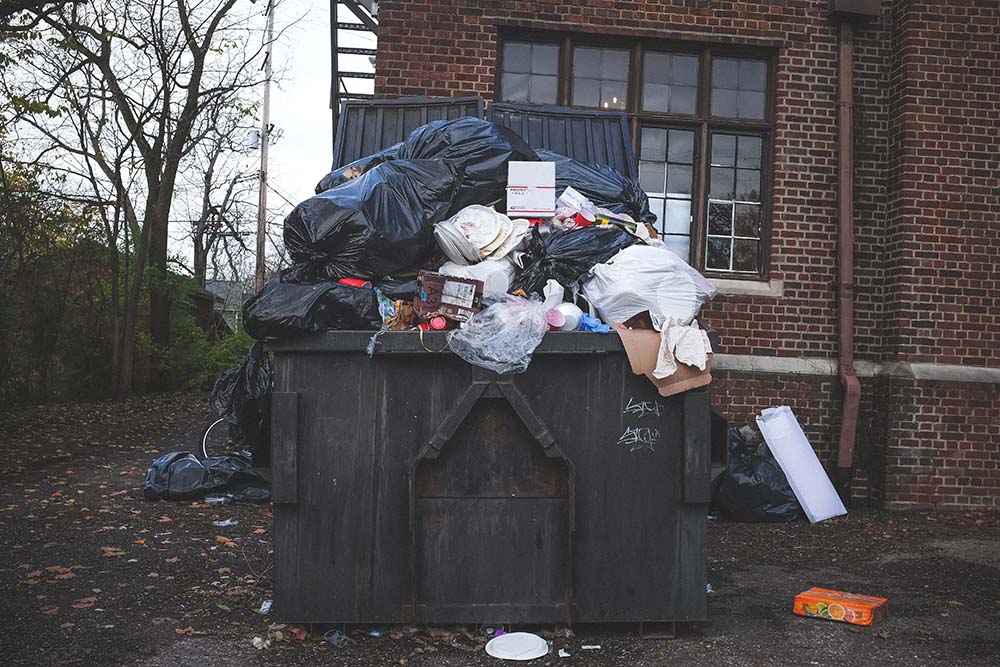“…contamination rates have in many ways become the most important metric in the recycling sector.” — Waste Dive
Recycling contamination happens when non-recyclable materials end up in your recycling stream. For example when food is left in recyclable containers that are placed in the recycling bin, or if items like plastic bags, wire hangers, and hazardous waste are mixed in with your recycling.
When recyclables are contaminated, they cannot be recycled and are treated as trash. This means that your contaminated recycling is likely headed to the landfill. In other words, they lose their value, and you pay for their removal.
In addition, contaminants like plastic bags can damage recycling machines, and hazardous waste can be dangerous for workers. As a result, many businesses are being charged higher waste and recycling fees by service providers to deal with the contamination problem. Higher rates are also in part due to the China import ban and similar moves by other countries like Malaysia and Vietnam to restrict imports of contaminated scrap. Until new markets for recyclables open up, or better alternatives for processing recycling present themselves, U.S. recycling must clean up its act.
The good news is that recycling contamination can be reduced, and businesses can maintain the value of their recycling and control rising waste and recycling costs. Here is how businesses can clean up their recycling act in just 6 steps.
1. Educate
Education is key. We’ve worked with thousands of buildings, offices, and corporations over the years to educate their staff and tenants on how to recycle right. This includes instruction on proper recycling (emptying and rinsing out food containers, making sure everything is kept dry, etc.), and proper separation (using the designated bins for each type of recyclables). Make sure your staff and tenants understand your recycling program and how to use it.
2. Train Janitorial Crews
Once workers leave for the night, janitorial crews in many office buildings come in to move waste and recycling to central collection points. Mistakes by janitorial crews can negate all the effort your staff and tenants put into recycling. For example, cleaners might place a half-filled beverage cup they find on a desk into the recycling bin. This contaminates all the recyclables, turning them into trash. Janitorial crews should be trained on proper handling of waste and recycling, and how to prevent contamination.
3. Use Proper Signage and Standardized Labels
Ensuring effective placement of signage and using standardized recycling bins labels are also part of the solution. They reduce confusion and therefore contamination. Moreover, proper signage may be required by law in your area, and being in compliance will help you avoid fines that can balloon.
4. Develop An Effective Waste and Recycling Program
In addition to education, training and signage, developing a program that works with the logistics and layout of your office or building is important.
For example, when we helped a large financial services firm in NYC transition from deskside bins to a centralized waste bin system, they experience a 75% reduction in the amount of recyclable materials being thrown in the trash, and less contamination mistakes were made overall. (Download our free white paper to learn more about the future of office waste management.)
Part of the reason is because office workers who had to walk to the centralized waste and recycling area in their office placed more thought into what they were actually planning to do. Central recycling locations like the pantry also make it easier for workers to empty out or rinse their recyclable containers before placing them in the proper bins.
5. Conduct A Waste Audit
Waste audits can give you a clear picture of the size of your recycling contamination problem, along with other crucial data. A waste audit can tell you what you are throwing away, what you are diverting, and how effectively (or not) your waste and recycling programs are working.
6. Move Towards Zero Waste
One of the best ways to reduce recycling contamination is to reduce the amount of waste generated in the first place. With rising waste and recycling costs and increasing regulations regarding recycling, the only long term sustainable solution lies in adopting zero waste strategies and reaping the many benefits.
The key thing to remember is that going Zero Waste does not mean producing no waste at all. Reduction is the key goal of Zero Waste, and that means less waste and more effective recycling coupled with more reuse and resource efficiency, all with the ultimate goal of closing that loop. Moving towards Zero Waste is very achievable for businesses. Here’s how to move towards zero waste in 3 steps.
Photo: Unsplash

